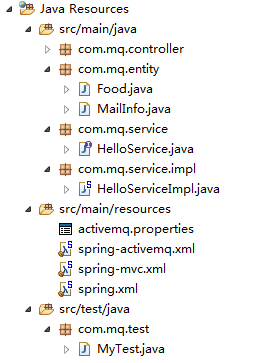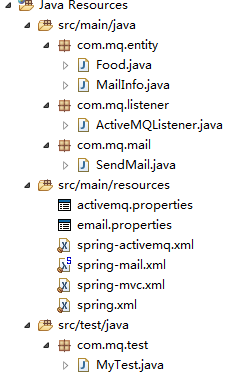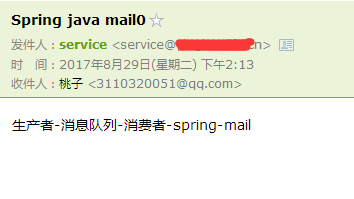原来有个教程是关于Javamail的,但是那个是自己写Javamail的发送过程,这次不同的是:使用Spring的Mail功能,使用了消息队列。
先看一下设想的场景

不过本文重点不是消息队列,而是使用spring发送邮件。
首先针对于不会Maven和消息队列的小盆友们
依赖jar包:
spring系列jar包
Javamail
先建立一个封装Mail信息的类:很好理解,里面的成员变量代表(收件人,主题,内容)
package com.mq.entity; import java.io.Serializable; public class MailInfo implements Serializable { /** * */ private static final long serialVersionUID = -5853264487189248317L; private String to; private String subject; private String content; public MailInfo() { } public MailInfo(String to, String subject, String content) { this.to = to; this.subject = subject; this.content = content; } public String getTo() { return to; } public void setTo(String to) { this.to = to; } public String getSubject() { return subject; } public void setSubject(String subject) { this.subject = subject; } public String getContent() { return content; } public void setContent(String content) { this.content = content; } }
然后呢,在classpath下面整一个属性文件,email.properties
mail.account=用户名 mail.pass=密码 mail.host=smtp.exmail.qq.com mail.port=465 mail.protocol=smtp mail.debug=true mail.smtp.auth=true mail.smtp.ssl.enable=true
注意:企业邮箱不用什么授权码,就是密码
然后classpath下建立spring配置文件。
<?xml version="1.0" encoding="UTF-8"?> <beans xmlns="http://www.springframework.org/schema/beans" xmlns:xsi="http://www.w3.org/2001/XMLSchema-instance" xmlns:context="http://www.springframework.org/schema/context" xmlns:core="http://activemq.apache.org/schema/core" xmlns:task="http://www.springframework.org/schema/task" xsi:schemaLocation="http://www.springframework.org/schema/beans http://www.springframework.org/schema/beans/spring-beans.xsd http://www.springframework.org/schema/context http://www.springframework.org/schema/context/spring-context-4.3.xsd http://activemq.apache.org/schema/core http://activemq.apache.org/schema/core http://www.springframework.org/schema/task http://www.springframework.org/schema/task/spring-task-4.3.xsd"> <context:component-scan base-package="com.mq.mail"></context:component-scan> <context:property-placeholder location="classpath:email.properties"/> <!-- 使用SSL,企业邮箱必需! --> <bean id="mailSSLSocketFactory" class="com.sun.mail.util.MailSSLSocketFactory"> <property name="trustAllHosts" value="true"></property> </bean> <bean id="javaMailSender" class="org.springframework.mail.javamail.JavaMailSenderImpl"> <property name="host" value="${mail.host}"></property> <property name="port" value="${mail.port}"></property> <property name="username" value="${mail.account}"></property> <property name="password" value="${mail.pass}"></property> <property name="protocol" value="${mail.protocol}"></property> <property name="defaultEncoding" value="UTF-8"></property> <!-- --> <property name="javaMailProperties"> <props> <!-- 使用SMTP身份验证 --> <prop key="mail.smtp.auth">${mail.smtp.auth}</prop> <!-- Debug模式 --> <prop key="mail.debug">${mail.debug}</prop> <!-- 使用SSL --> <prop key="mail.smtp.ssl.enable">${mail.smtp.ssl.enable}</prop> <!-- 配置MailSSLSocketFactory --> <prop key="mail.smtp.ssl.socketFactory">mailSSLSocketFactory</prop> </props> </property> </bean> <bean id="simpleMailMessage" class="org.springframework.mail.SimpleMailMessage"> <property name="from" value="${mail.account}"></property> </bean> <bean id="threadPoolTaskExecutor" class="org.springframework.scheduling.concurrent.ThreadPoolTaskExecutor"> <!-- 线程池维护线程的最少数量 --> <property name="corePoolSize" value="5" /> <!-- 线程池维护线程的最大数量 --> <property name="maxPoolSize" value="20" /> <!-- 线程池维护线程所允许的空闲时间 --> <property name="keepAliveSeconds" value="30000" /> <!-- 线程池所使用的缓冲队列 --> <property name="queueCapacity" value="1000" /> </bean> </beans>
然后写一个发送邮件类
package com.mq.mail; import org.springframework.beans.factory.annotation.Autowired; import org.springframework.mail.SimpleMailMessage; import org.springframework.mail.javamail.JavaMailSender; import org.springframework.scheduling.concurrent.ThreadPoolTaskExecutor; import org.springframework.stereotype.Component; import com.mq.entity.MailInfo; @Component public class SendMail { @Autowired private JavaMailSender javaMailSender; @Autowired private SimpleMailMessage simpleMailMessage; @Autowired private ThreadPoolTaskExecutor threadPoolTaskExecutor; public void send(final MailInfo mailInfo){ threadPoolTaskExecutor.execute(new Runnable() { @Override public void run() { try { simpleMailMessage.setTo(mailInfo.getTo()); simpleMailMessage.setSubject(mailInfo.getSubject()); simpleMailMessage.setText(mailInfo.getContent()); javaMailSender.send(simpleMailMessage); } catch (Exception e) { e.printStackTrace(); } } }); } }
最后写一个测试类:
package com.mq.test; import org.springframework.context.support.ClassPathXmlApplicationContext; import com.mq.entity.MailInfo; import com.mq.mail.SendMail; public class TestMail { public static void main(String[] args) { ClassPathXmlApplicationContext app = new ClassPathXmlApplicationContext("classpath:spring-mail.xml"); app.start(); MailInfo mailInfo = new MailInfo("XXX@qq.com", "这是主题", "这是内容"); app.getBean(SendMail.class).send(mailInfo); app.close(); } }
结果:

下面是Maven+消息队列的部分
我有两个工程,一个是生产者,一个是消费者。都是Maven的web工程。PS:这两个工程加入了mvc,因为本来想做个好玩的东西的,但是太忙了,先放下了,目前只有利用消息队列发送邮件的部分。这也是为啥依赖这么多的原因。
首先是生产者
Maven依赖:
<properties> <spring.version>4.3.9.RELEASE</spring.version> </properties> <dependencies> <!-- https://mvnrepository.com/artifact/junit/junit --> <dependency> <groupId>junit</groupId> <artifactId>junit</artifactId> <version>4.12</version> <scope>test</scope> </dependency> <!-- https://mvnrepository.com/artifact/org.springframework/spring-test --> <dependency> <groupId>org.springframework</groupId> <artifactId>spring-test</artifactId> <version>${spring.version}</version> <scope>test</scope> </dependency> <dependency> <groupId>org.springframework</groupId> <artifactId>spring-context</artifactId> <version>${spring.version}</version> </dependency> <dependency> <groupId>org.springframework</groupId> <artifactId>spring-context-support</artifactId> <version>${spring.version}</version> </dependency> <dependency> <groupId>org.springframework</groupId> <artifactId>spring-aop</artifactId> <version>${spring.version}</version> </dependency> <dependency> <groupId>org.springframework</groupId> <artifactId>spring-beans</artifactId> <version>${spring.version}</version> </dependency> <dependency> <groupId>org.springframework</groupId> <artifactId>spring-core</artifactId> <version>${spring.version}</version> </dependency> <dependency> <groupId>org.springframework</groupId> <artifactId>spring-jms</artifactId> <version>${spring.version}</version> </dependency> <dependency> <groupId>org.springframework</groupId> <artifactId>spring-tx</artifactId> <version>${spring.version}</version> </dependency> <dependency> <groupId>org.springframework</groupId> <artifactId>spring-web</artifactId> <version>${spring.version}</version> </dependency> <dependency> <groupId>org.springframework</groupId> <artifactId>spring-webmvc</artifactId> <version>${spring.version}</version> </dependency> <dependency> <groupId>org.springframework</groupId> <artifactId>spring-aspects</artifactId> <version>${spring.version}</version> </dependency> <dependency> <groupId>org.springframework</groupId> <artifactId>spring-expression</artifactId> <version>${spring.version}</version> </dependency> <dependency> <groupId>org.springframework</groupId> <artifactId>spring-messaging</artifactId> <version>${spring.version}</version> </dependency> <dependency> <groupId>org.apache.activemq</groupId> <artifactId>activemq-all</artifactId> <version>5.15.0</version> </dependency> <dependency> <groupId>org.apache.activemq</groupId> <artifactId>activemq-pool</artifactId> <version>5.15.0</version> </dependency> <dependency> <groupId>com.alibaba</groupId> <artifactId>fastjson</artifactId> <version>1.2.35</version> </dependency> <!-- https://mvnrepository.com/artifact/com.fasterxml.jackson.core/jackson-core --> <dependency> <groupId>com.fasterxml.jackson.core</groupId> <artifactId>jackson-core</artifactId> <version>2.8.9</version> </dependency> <!-- https://mvnrepository.com/artifact/com.fasterxml.jackson.core/jackson-databind --> <dependency> <groupId>com.fasterxml.jackson.core</groupId> <artifactId>jackson-databind</artifactId> <version>2.8.9</version> </dependency> <!-- https://mvnrepository.com/artifact/com.fasterxml.jackson.core/jackson-annotations --> <dependency> <groupId>com.fasterxml.jackson.core</groupId> <artifactId>jackson-annotations</artifactId> <version>2.8.9</version> </dependency> <!-- https://mvnrepository.com/artifact/javax.mail/mail --> <dependency> <groupId>javax.mail</groupId> <artifactId>mail</artifactId> <version>1.4.7</version> </dependency> <dependency> <groupId>javax.servlet</groupId> <artifactId>jstl</artifactId> <version>1.2</version> </dependency> </dependencies>
建立ActiveMQ的属性文件:activemq.properties
activemq.brokerUrl=tcp://localhost:61616 activemq.userName=admin activemq.password=admin activemq.pool.maxConnection=10 activemq.queueName=foodQueue activemq.topicName=foodTopic
因为是本地测试,我就在windows系统启动了一个ActiveMQ。
下面建立spring-activemq.xml
<?xml version="1.0" encoding="UTF-8"?> <beans xmlns="http://www.springframework.org/schema/beans" xmlns:xsi="http://www.w3.org/2001/XMLSchema-instance" xmlns:context="http://www.springframework.org/schema/context" xmlns:core="http://activemq.apache.org/schema/core" xmlns:jms="http://www.springframework.org/schema/jms" xmlns:mvc="http://www.springframework.org/schema/mvc" xsi:schemaLocation="http://www.springframework.org/schema/beans http://www.springframework.org/schema/beans/spring-beans.xsd http://www.springframework.org/schema/context http://www.springframework.org/schema/context/spring-context-4.3.xsd http://activemq.apache.org/schema/core http://activemq.apache.org/schema/core http://www.springframework.org/schema/jms http://www.springframework.org/schema/jms/spring-jms-4.3.xsd http://www.springframework.org/schema/mvc http://www.springframework.org/schema/mvc/spring-mvc-4.3.xsd"> <context:component-scan base-package="com.mq.service"></context:component-scan> <mvc:annotation-driven></mvc:annotation-driven> <context:property-placeholder location="classpath:activemq.properties"/> <!-- Spring提供的ConnectionFactory只是Spring用于管理ConnectionFactory的, 真正产生到JMS服务器链接的ConnectionFactory还得是由JMS服务厂商提供,并且需要把它注入到Spring提供的ConnectionFactory中。 --> <bean id="activeMQConnectionFactory" class="org.apache.activemq.ActiveMQConnectionFactory"> <property name="brokerURL" value="${activemq.brokerUrl}"></property> <property name="userName" value="${activemq.userName}"></property> <property name="password" value="${activemq.password}"></property> </bean> <!-- ActiveMQ为我们提供了一个PooledConnectionFactory,通过往里面注入一个ActiveMQConnectionFactory 可以用来将Connection、Session和MessageProducer池化,这样可以大大的减少我们的资源消耗。 --> <bean id="pooledConnectionFactory" class="org.apache.activemq.pool.PooledConnectionFactory"> <property name="connectionFactory" ref="activeMQConnectionFactory"></property> <property name="maxConnections" value="${activemq.pool.maxConnection}"></property> </bean> <!-- ConnectionFactory是用于产生到JMS服务器的链接的,Spring为我们提供了多个ConnectionFactory,有SingleConnectionFactory和CachingConnectionFactory。 SingleConnectionFactory对于建立JMS服务器链接的请求会一直返回同一个链接,并且会忽略Connection的close方法调用。 CachingConnectionFactory继承了SingleConnectionFactory,所以它拥有SingleConnectionFactory的所有功能,同时它还新增了缓存功能,它可以缓存Session、MessageProducer和MessageConsumer。 --> <bean id="connectionFactory" class="org.springframework.jms.connection.SingleConnectionFactory"> <property name="targetConnectionFactory" ref="pooledConnectionFactory"></property> </bean> <!-- 在真正利用JmsTemplate进行消息发送的时候,我们需要知道消息发送的目的地,即destination。 在Jms中有一个用来表示目的地的Destination接口,它里面没有任何方法定义,只是用来做一个标识而已。 当我们在使用JmsTemplate进行消息发送时没有指定destination的时候将使用默认的Destination。 默认Destination可以通过在定义jmsTemplate bean对象时通过属性defaultDestination或defaultDestinationName来进行注入, defaultDestinationName对应的就是一个普通字符串。在ActiveMQ中实现了两种类型的Destination, 一个是点对点的ActiveMQQueue,另一个就是支持订阅/发布模式的ActiveMQTopic。 在定义这两种类型的Destination时我们都可以通过一个name属性来进行构造 --> <!-- 定义消息队列 --> <bean id="queueDestination" class="org.apache.activemq.command.ActiveMQQueue"> <constructor-arg> <value>${activemq.queueName}</value> </constructor-arg> </bean> <!-- 定义主题 --> <bean id="topicDestination" class="org.apache.activemq.command.ActiveMQTopic"> <constructor-arg> <value>${activemq.topicName}</value> </constructor-arg> </bean> <!-- 配置JMS模板,Spring提供的JMS工具类,它发送、接收消息。 --> <bean id="jmsTemplate" class="org.springframework.jms.core.JmsTemplate"> <property name="connectionFactory" ref="connectionFactory"></property> <!-- <property name="defaultDestinationName" value="${activemq.queueName}"></property> --> <property name="defaultDestination" ref="queueDestination"></property> </bean> </beans>
spring.xml
<?xml version="1.0" encoding="UTF-8"?> <beans xmlns="http://www.springframework.org/schema/beans" xmlns:xsi="http://www.w3.org/2001/XMLSchema-instance" xmlns:aop="http://www.springframework.org/schema/aop" xmlns:context="http://www.springframework.org/schema/context" xmlns:core="http://activemq.apache.org/schema/core" xmlns:tx="http://www.springframework.org/schema/tx" xsi:schemaLocation="http://www.springframework.org/schema/beans http://www.springframework.org/schema/beans/spring-beans.xsd http://www.springframework.org/schema/aop http://www.springframework.org/schema/aop/spring-aop-4.3.xsd http://www.springframework.org/schema/context http://www.springframework.org/schema/context/spring-context-4.3.xsd http://activemq.apache.org/schema/core http://activemq.apache.org/schema/core http://www.springframework.org/schema/tx http://www.springframework.org/schema/tx/spring-tx-4.3.xsd"> <import resource="classpath:spring-activemq.xml"/> </beans>
接下来写代码,目录结构如下:(你不需要考虑controller,以及spring-mvc.xml,以及Food)

建立Mail信息类:

package com.mq.entity; import java.io.Serializable; public class MailInfo implements Serializable { /** * */ private static final long serialVersionUID = -5853264487189248317L; private String to; private String subject; private String content; public MailInfo() { } public MailInfo(String to, String subject, String content) { this.to = to; this.subject = subject; this.content = content; } public String getTo() { return to; } public void setTo(String to) { this.to = to; } public String getSubject() { return subject; } public void setSubject(String subject) { this.subject = subject; } public String getContent() { return content; } public void setContent(String content) { this.content = content; } }
关于那个Food是我测试着玩的哈哈,满足你的好奇心

package com.mq.entity; import java.io.Serializable; import java.util.Date; public class Food implements Serializable { private static final long serialVersionUID = 1L; private String foodName; private double foodPrice; private int foodNumber; private Date orderTime; public Food() { } public Food(String foodName, double foodPrice, int foodNumber, Date orderTime) { super(); this.foodName = foodName; this.foodPrice = foodPrice; this.foodNumber = foodNumber; this.orderTime = orderTime; } public String getFoodName() { return foodName; } public void setFoodName(String foodName) { this.foodName = foodName; } public double getFoodPrice() { return foodPrice; } public void setFoodPrice(double foodPrice) { this.foodPrice = foodPrice; } public int getFoodNumber() { return foodNumber; } public void setFoodNumber(int foodNumber) { this.foodNumber = foodNumber; } public Date getOrderTime() { return orderTime; } public void setOrderTime(Date orderTime) { this.orderTime = orderTime; } @Override public String toString() { return "Food [foodName=" + foodName + ", foodPrice=" + foodPrice + ", foodNumber=" + foodNumber + ", orderTime=" + orderTime + "]"; } }
消息服务接口
package com.mq.service; import javax.jms.Destination; import org.springframework.stereotype.Service; import com.mq.entity.Food; import com.mq.entity.MailInfo; @Service public interface HelloService { void sendMessage(Destination destination, Food food); void sendMail(Destination destination, MailInfo mail); }
消息服务实现:
package com.mq.service.impl; import javax.jms.Destination; import javax.jms.JMSException; import javax.jms.Message; import javax.jms.Session; import org.springframework.beans.factory.annotation.Autowired; import org.springframework.jms.core.JmsTemplate; import org.springframework.jms.core.MessageCreator; import org.springframework.stereotype.Service; import com.alibaba.fastjson.JSONObject; import com.mq.entity.Food; import com.mq.entity.MailInfo; import com.mq.service.HelloService; @Service public class HelloServiceImpl implements HelloService { @Autowired private JmsTemplate jmsTemplate; @Override public void sendMessage(Destination destination, Food food){ jmsTemplate.send(destination, new MessageCreator() { @Override public Message createMessage(Session session) throws JMSException { return session.createTextMessage(JSONObject.toJSONString(food)); // return session.createObjectMessage(new Food("蛋糕", 66.5, 1, new Date())); } }); } @Override public void sendMail(Destination destination, MailInfo mail) { jmsTemplate.send(destination, new MessageCreator() { @Override public Message createMessage(Session session) throws JMSException { return session.createTextMessage(JSONObject.toJSONString(mail)); } }); } }
最后是测试类,这里使用了springTest。
package com.mq.test; import javax.jms.Destination; import org.junit.Test; import org.junit.runner.RunWith; import org.springframework.beans.factory.annotation.Autowired; import org.springframework.beans.factory.annotation.Qualifier; import org.springframework.test.context.ContextConfiguration; import org.springframework.test.context.junit4.SpringJUnit4ClassRunner; import com.mq.entity.MailInfo; import com.mq.service.HelloService; @ContextConfiguration(locations={"classpath:spring.xml"}) @RunWith(SpringJUnit4ClassRunner.class) public class MyTest { //@Autowired与@Resource都可以用来装配bean. 都可以写在字段上,或写在setter方法上。 //使用@Autowired的话,想使用名称装配可以结合@Qualifier注解进行使用 //@Resource(这个注解属于J2EE的),默认安照名称进行装配,名称可以通过name属性进行指定, //如果没有指定name属性,当注解写在字段上时,默认取字段名进行按照名称查找,如果注解写在setter方法上默认取属性名进行装配。 @Autowired private HelloService helloService; @Autowired @Qualifier("queueDestination") private Destination destination; @Test public void test(){ //helloService.sendMessage(destination, new Food("蛋糕", 66.5, 1, new Date())); for (int i = 0; i < 1; i++) { helloService.sendMail(destination, new MailInfo("XXX@qq.com", "Spring java mail"+i, "生产者-消息队列-消费者-spring-mail")); } } }
下面是消费者:
依赖和生产者一样的,这里不重复了。activemq.properties也一样。
邮箱属性文件:
mail.account=用户名 mail.pass=密码 mail.host=smtp.exmail.qq.com mail.port=465 mail.protocol=smtp mail.debug=true mail.smtp.auth=true mail.smtp.ssl.enable=true
spring-activemq.xml:
<?xml version="1.0" encoding="UTF-8"?> <beans xmlns="http://www.springframework.org/schema/beans" xmlns:xsi="http://www.w3.org/2001/XMLSchema-instance" xmlns:context="http://www.springframework.org/schema/context" xmlns:core="http://activemq.apache.org/schema/core" xmlns:jms="http://www.springframework.org/schema/jms" xmlns:mvc="http://www.springframework.org/schema/mvc" xsi:schemaLocation="http://www.springframework.org/schema/beans http://www.springframework.org/schema/beans/spring-beans.xsd http://www.springframework.org/schema/context http://www.springframework.org/schema/context/spring-context-4.3.xsd http://activemq.apache.org/schema/core http://activemq.apache.org/schema/core http://www.springframework.org/schema/jms http://www.springframework.org/schema/jms/spring-jms-4.3.xsd http://www.springframework.org/schema/mvc http://www.springframework.org/schema/mvc/spring-mvc-4.3.xsd"> <mvc:annotation-driven></mvc:annotation-driven> <!-- <context:property-placeholder location="classpath:activemq.properties"/> --> <!-- Spring提供的ConnectionFactory只是Spring用于管理ConnectionFactory的, 真正产生到JMS服务器链接的ConnectionFactory还得是由JMS服务厂商提供,并且需要把它注入到Spring提供的ConnectionFactory中。 --> <bean id="activeMQConnectionFactory" class="org.apache.activemq.ActiveMQConnectionFactory"> <property name="brokerURL" value="${activemq.brokerUrl}"></property> <property name="userName" value="${activemq.userName}"></property> <property name="password" value="${activemq.password}"></property> </bean> <!-- ActiveMQ为我们提供了一个PooledConnectionFactory,通过往里面注入一个ActiveMQConnectionFactory 可以用来将Connection、Session和MessageProducer池化,这样可以大大的减少我们的资源消耗。 --> <bean id="pooledConnectionFactory" class="org.apache.activemq.pool.PooledConnectionFactory"> <property name="connectionFactory" ref="activeMQConnectionFactory"></property> <property name="maxConnections" value="${activemq.pool.maxConnection}"></property> </bean> <!-- ConnectionFactory是用于产生到JMS服务器的链接的,Spring为我们提供了多个ConnectionFactory,有SingleConnectionFactory和CachingConnectionFactory。 SingleConnectionFactory对于建立JMS服务器链接的请求会一直返回同一个链接,并且会忽略Connection的close方法调用。 CachingConnectionFactory继承了SingleConnectionFactory,所以它拥有SingleConnectionFactory的所有功能,同时它还新增了缓存功能,它可以缓存Session、MessageProducer和MessageConsumer。 --> <bean id="connectionFactory" class="org.springframework.jms.connection.SingleConnectionFactory"> <property name="targetConnectionFactory" ref="pooledConnectionFactory"></property> </bean> <!-- 在真正利用JmsTemplate进行消息发送的时候,我们需要知道消息发送的目的地,即destination。 在Jms中有一个用来表示目的地的Destination接口,它里面没有任何方法定义,只是用来做一个标识而已。 当我们在使用JmsTemplate进行消息发送时没有指定destination的时候将使用默认的Destination。 默认Destination可以通过在定义jmsTemplate bean对象时通过属性defaultDestination或defaultDestinationName来进行注入, defaultDestinationName对应的就是一个普通字符串。在ActiveMQ中实现了两种类型的Destination, 一个是点对点的ActiveMQQueue,另一个就是支持订阅/发布模式的ActiveMQTopic。 在定义这两种类型的Destination时我们都可以通过一个name属性来进行构造 --> <!-- 定义消息队列 --> <bean id="queueDestination" class="org.apache.activemq.command.ActiveMQQueue"> <constructor-arg> <value>${activemq.queueName}</value> </constructor-arg> </bean> <!-- 定义主题 --> <bean id="topicDestination" class="org.apache.activemq.command.ActiveMQTopic"> <constructor-arg> <value>${activemq.topicName}</value> </constructor-arg> </bean> <!-- 装配监听器 --> <bean id="mqListener" class="com.mq.listener.ActiveMQListener"></bean> <!-- 消费者是如何知道有生产者发送消息到指定目的地Destination了呢?这是通过Spring为我们封装的消息监听容器MessageListenerContainer实现的,它负责接收信息,并把接收到的信息分发给真正的MessageListener进行处理。 我们在配置一个MessageListenerContainer的时候有三个属性必须指定,一个是表示从哪里监听的ConnectionFactory;一个是表示监听什么的Destination;一个是接收到消息以后进行消息处理的MessageListener。 Spring一共为我们提供了两种类型的MessageListenerContainer,SimpleMessageListenerContainer和DefaultMessageListenerContainer。 大多数情况下我们还是使用的DefaultMessageListenerContainer,跟SimpleMessageListenerContainer相比,DefaultMessageListenerContainer会动态的适应运行时需要,并且能够参与外部的事务管理。 --> <bean id="jmsContainer" class="org.springframework.jms.listener.DefaultMessageListenerContainer"> <property name="connectionFactory" ref="connectionFactory"></property> <property name="destination" ref="queueDestination"></property> <property name="messageListener" ref="mqListener"></property> </bean> </beans>
spring-mail.xml:
<?xml version="1.0" encoding="UTF-8"?> <beans xmlns="http://www.springframework.org/schema/beans" xmlns:xsi="http://www.w3.org/2001/XMLSchema-instance" xmlns:context="http://www.springframework.org/schema/context" xmlns:core="http://activemq.apache.org/schema/core" xmlns:task="http://www.springframework.org/schema/task" xsi:schemaLocation="http://www.springframework.org/schema/beans http://www.springframework.org/schema/beans/spring-beans.xsd http://www.springframework.org/schema/context http://www.springframework.org/schema/context/spring-context-4.3.xsd http://activemq.apache.org/schema/core http://activemq.apache.org/schema/core http://www.springframework.org/schema/task http://www.springframework.org/schema/task/spring-task-4.3.xsd"> <!-- 使用SSL,企业邮箱必需! --> <bean id="mailSSLSocketFactory" class="com.sun.mail.util.MailSSLSocketFactory"> <property name="trustAllHosts" value="true"></property> </bean> <bean id="javaMailSender" class="org.springframework.mail.javamail.JavaMailSenderImpl"> <property name="host" value="${mail.host}"></property> <property name="port" value="${mail.port}"></property> <property name="username" value="${mail.account}"></property> <property name="password" value="${mail.pass}"></property> <property name="protocol" value="${mail.protocol}"></property> <property name="defaultEncoding" value="UTF-8"></property> <!-- --> <property name="javaMailProperties"> <props> <!-- 使用SMTP身份验证 --> <prop key="mail.smtp.auth">${mail.smtp.auth}</prop> <!-- Debug模式 --> <prop key="mail.debug">${mail.debug}</prop> <!-- 使用SSL --> <prop key="mail.smtp.ssl.enable">${mail.smtp.ssl.enable}</prop> <!-- 配置MailSSLSocketFactory --> <prop key="mail.smtp.ssl.socketFactory">mailSSLSocketFactory</prop> </props> </property> </bean> <bean id="simpleMailMessage" class="org.springframework.mail.SimpleMailMessage"> <property name="from" value="${mail.account}"></property> </bean> <bean id="threadPoolTaskExecutor" class="org.springframework.scheduling.concurrent.ThreadPoolTaskExecutor"> <!-- 线程池维护线程的最少数量 --> <property name="corePoolSize" value="5" /> <!-- 线程池维护线程的最大数量 --> <property name="maxPoolSize" value="20" /> <!-- 线程池维护线程所允许的空闲时间 --> <property name="keepAliveSeconds" value="30000" /> <!-- 线程池所使用的缓冲队列 --> <property name="queueCapacity" value="1000" /> </bean> </beans>
spring.xml
<?xml version="1.0" encoding="UTF-8"?> <beans xmlns="http://www.springframework.org/schema/beans" xmlns:xsi="http://www.w3.org/2001/XMLSchema-instance" xmlns:aop="http://www.springframework.org/schema/aop" xmlns:context="http://www.springframework.org/schema/context" xmlns:core="http://activemq.apache.org/schema/core" xmlns:tx="http://www.springframework.org/schema/tx" xsi:schemaLocation="http://www.springframework.org/schema/beans http://www.springframework.org/schema/beans/spring-beans.xsd http://www.springframework.org/schema/aop http://www.springframework.org/schema/aop/spring-aop-4.3.xsd http://www.springframework.org/schema/context http://www.springframework.org/schema/context/spring-context-4.3.xsd http://activemq.apache.org/schema/core http://activemq.apache.org/schema/core http://www.springframework.org/schema/tx http://www.springframework.org/schema/tx/spring-tx-4.3.xsd"> <context:component-scan base-package="com.mq.entity,com.mq.mail"></context:component-scan> <!-- 不允许有多个属性文件标签,所以只能把项目中的属性文件统一读取 --> <context:property-placeholder location="classpath:activemq.properties,classpath:email.properties"/> <import resource="spring-activemq.xml"/> <import resource="spring-mail.xml"/> </beans>
下面是工程结构:entity不说了,是一样的。

ActiveMQ监听器:
package com.mq.listener; import javax.jms.JMSException; import javax.jms.Message; import javax.jms.MessageListener; import javax.jms.TextMessage; import org.springframework.beans.factory.annotation.Autowired; import com.alibaba.fastjson.JSONObject; import com.mq.entity.MailInfo; import com.mq.mail.SendMail; public class ActiveMQListener implements MessageListener { @Autowired private SendMail sendMail; @Override public void onMessage(Message message) { TextMessage text = (TextMessage) message; try { MailInfo mail = JSONObject.parseObject(text.getText(), MailInfo.class); if(mail != null){ System.out.println(mail.getTo() + "," + mail.getSubject() + "," + mail.getContent()); System.out.println("发送邮件..."); sendMail.send(mail); } } catch (JMSException e) { // TODO Auto-generated catch block e.printStackTrace(); } // try { // System.out.println(text.getText()); // Food food = JSONObject.parseObject(text.getText(), Food.class); // System.out.println("============收到消息==========="); // System.out.println(food); // } catch (JMSException e) { // e.printStackTrace(); // } } }
SendMail:
package com.mq.mail; import org.springframework.beans.factory.annotation.Autowired; import org.springframework.mail.SimpleMailMessage; import org.springframework.mail.javamail.JavaMailSender; import org.springframework.scheduling.concurrent.ThreadPoolTaskExecutor; import org.springframework.stereotype.Component; import com.mq.entity.MailInfo; @Component public class SendMail { @Autowired private JavaMailSender javaMailSender; @Autowired private SimpleMailMessage simpleMailMessage; @Autowired private ThreadPoolTaskExecutor threadPoolTaskExecutor; public void send(final MailInfo mailInfo){ threadPoolTaskExecutor.execute(new Runnable() { @Override public void run() { try { simpleMailMessage.setTo(mailInfo.getTo()); simpleMailMessage.setSubject(mailInfo.getSubject()); simpleMailMessage.setText(mailInfo.getContent()); javaMailSender.send(simpleMailMessage); } catch (Exception e) { e.printStackTrace(); } } }); } }
最后测试:
package com.mq.test; import javax.jms.Destination; import org.junit.Test; import org.junit.runner.RunWith; import org.springframework.beans.factory.annotation.Autowired; import org.springframework.beans.factory.annotation.Qualifier; import org.springframework.test.context.ContextConfiguration; import org.springframework.test.context.junit4.SpringJUnit4ClassRunner; @ContextConfiguration(locations={"classpath:spring.xml"}) @RunWith(SpringJUnit4ClassRunner.class) public class MyTest { //@Autowired与@Resource都可以用来装配bean. 都可以写在字段上,或写在setter方法上。 //使用@Autowired的话,想使用名称装配可以结合@Qualifier注解进行使用 //@Resource(这个注解属于J2EE的),默认安照名称进行装配,名称可以通过name属性进行指定, //如果没有指定name属性,当注解写在字段上时,默认取字段名进行按照名称查找,如果注解写在setter方法上默认取属性名进行装配。 @Autowired @Qualifier("queueDestination") private Destination destination; @Test public void test(){ try { Thread.sleep(Integer.MAX_VALUE); } catch (InterruptedException e) { // TODO Auto-generated catch block e.printStackTrace(); } //在单元测试里,如果test方法先于我们要执行的任务结束,会导致任务出错,所以我们这里睡眠了MAX秒,就为了给我们的任务争取时间 } }
先启动ActiveMQ,然后执行生产者的test方法,

然后执行消费者的test方法。

结果:

你运行的时候记得修改收件人哦,别给我发哦。
